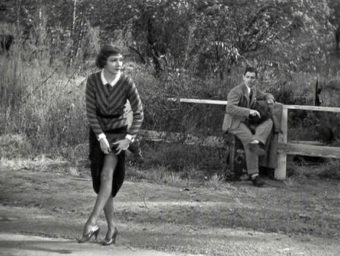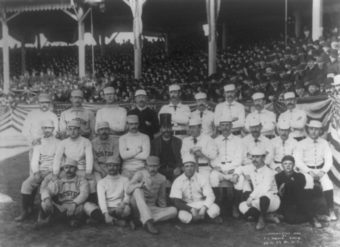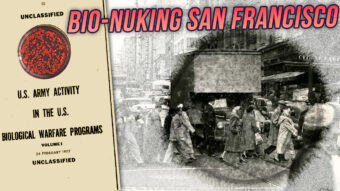 Sticking your thumb out to convey some meaning has seemingly been around for about as long as humans have been humaning, or, at least, as far back as written history goes. But how did the gesture come to be a signal that you’d like to hitch a ride from someone? And is hitching a ride actually dangerous?
Sticking your thumb out to convey some meaning has seemingly been around for about as long as humans have been humaning, or, at least, as far back as written history goes. But how did the gesture come to be a signal that you’d like to hitch a ride from someone? And is hitching a ride actually dangerous?
To begin with, almost as soon as the automobile began to become popular in the United States, “thumbing” seems to have become a thing in lock step. As to why this, and not some other gesture, it is often put forth that this is attached to the idea that “thumbs up” means like “ok”, “yes”, “do it” etc. So, in essence, staring the person down in the car and giving them the thumbs up/positive gesture in hopes they’ll stop. The issue with this hypothesis, however, is that that particular “ok” or positive meaning of the gesture didn’t definitively become a widely popular thing until after WWII, a few decades after thumbing a ride was already well established.
Now, at this point, if you’ve watched basically any movie or show featuring Roman gladiators, you might already be heading to the comments to argue with us, as the thumbs up after a fight supposedly meant live and the thumbs down meant die, with this being the commonly touted origin of the whole thumbs up / positive / yes / ok meaning in the first place.
However, this is unequivocally false. While it is true that in the days of gladiatorial combat in the Colosseum and the earlier (and significantly larger) Circus Maximus, the audience could decide the fate of a fallen gladiator with a simple hand gesture, this isn’t typically depicted accurately and has nothing to do with why thumbs up and thumbs down means what it does today.
To wit, the fate of a gladiator, in terms of whether the audience was voting for a kill, was decided with what is known as “pollice verso”, a Latin term which roughly translates to “turned thumb”. More precisely what this means isn’t known and there are no accounts that have survived to this day that describe it in any real detail. As such, we’re unable to say for sure which way the thumb was supposed to be pointed if the audience wanted a given gladiator to be killed, or if they could just wave their thumbs around at random, which it seems may well have been the case. But either way, the turned thumb was to indicate not life, but death.
So what about indicating the person should live? The gesture to spare a given gladiator’s life seems to have been neither a thumbs up nor a thumbs down. Instead, you had to hide your thumb inside your fist, forming a gesture known as pollice compresso, “compressed thumb”.
The reasons for this have been speculated to be twofold: one, it made the decision of the crowd easier to discern, since it’s easier to tell the difference between a thumbs turned and a closed fist than a thumbs up and a thumbs down from a long ways away. And two, the gestures themselves are thought to be largely symbolic of what they represented- a pointed thumb represented the audience’s desire for the victorious gladiator to deliver his coup de grâce (stab the fallen foe), while a hidden thumb symbolised that they wished for the gladiator to stay his blade, sheathing it much in the way they’d hidden their thumbs. Hence why it’s thought “turned thumb” may well have been simply waving your thumb around in the air, perhaps in a stabbing motion.
Of course, moving on to hitchhiking, using the thumb as a symbolic sword to stab people isn’t probably going to increase your odds of getting picked up… So definitely no connection there. And, as mentioned, the thumbs up meaning more or less as we think of it today in the general, non-hitchhiking sense, didn’t really become popular until after WWII.
On this one, during WWII, the thumbs up gesture was used extensively by American pilots as a shorthand way of indicating to their ground crews that they were ready to fly.
It has been speculated that they got this from the Chinese, with specifically the Flying Tiger brigade of American pilots based in China seemingly being the first (or among the first) to popularly use the gesture, at least as far as photographic evidence from the era seems to indicate. To the Chinese at this time, the thumbs up gesture meant “number one” or “nice job” depending on context. (Why this is the case is up for debate.) Whether it truly was adopted from the Chinese or some other source, the American pilot version initially meant “I’m ready” or “good to go”.
From here, things become much clearer. This “ready” meaning soon evolved into a simple, all-encompassing way to indicate that everything was okay in situations where verbal cues weren’t possible or advisable. It was also picked up by the rest of the American military who proceeded to make extensive use of the gesture during their many campaigns across Europe; in the process, it was picked up by the locals and soldiers from other militaries.
That said, there are several places on Earth where a thumbs up is considered a grave insult. For example, in places like Iraq and Greece, sticking up your thumb is akin to saying “shove it up your ass” (which, like the stabbing meaning, probably also wouldn’t be the best way to hail down a car… unless they are into that… We here at TodayIFoundOut don’t judge. You do you.)
Noteworthy, it also meant this in Australia before WWII, but afterward switched to the modern meaning thanks to the aforementioned dissemination of the gesture throughout the Allied military. The exact reasoning behind this more insulting meaning, as with many gestures, isn’t clear, but it’s believed to be representative of the action that would be required for you to act out the insult itself. In fact, in some of these cultures that interpret it this way, an up and down movement often accompanies the gesture to make the meaning perfectly clear. Funnily enough on this one, when American troops first started being stationed in Iraq, some reported being greeted by civilians offering a thumbs up, with the soldiers (and many in the media) interpreting it as most Westerners would, all the while not realizing the obscene connotations it has in that country.
In any event, given the lack of hard evidence of the thumbs up meaning as we think of it today, at least popularly, before WWII, the hypothesis that there is a connection here with regards to the origin of the thumbs up in hitchhiking is, unsurprisingly, highly suspect.
Even more so when we really dig into the hard documented evidence of the evolution of the hitchhiking sign. Whoever was the first to do it, one of the earliest references to hitchhiking, though without mention of the thumbs out gesture, comes from American poet Vachel Lindsay, who wrote in 1916, “He it is that wants the other side of the machine weighed down. He it is that will offer me a ride and spin me along from five to twenty-five miles before supper.”
By 1923, the practice had been given its proper name in the Nation on September 19, with “Hitch-hiking is always done by twos or threes.” Some claim that its popularity arose with the increasing presence of more and more cars combined with the desire of soldiers on furlough during WWI to get home as cheaply as possible.
Whatever the case, the practice quickly became popular with other vehicularly-challenged folks as well, including college students, kids and even (*gasp*) girls by themselves (more on whether this is actually dangerous or not in a bit).
By 1925, however, we do have reference to not only the gesture being associated with hitchhiking, but also, in part at least, why the thumb was used. This comes to us from a 1925 article in American Magazine that described how “The hitch hiker stands at the edge of the road and point with his thumb in the direction he wishes to go.”
Further doubling down on this reasoning, around the same time “thumb-pointer” was also a synonym for “hitchhiker”. In other words, it appears the use of the thumb out originally was not so much a thumb’s up sign to hail a ride, but actually dually indicating you wanted to be picked up, as well as telling the driver which way you wanted to go.
Of course, early hitchhikers could have pointed in other ways, so why the thumb was settled on instead of the index finger isn’t really clear. Perhaps so as not to be confused with giving the finger from a distance (and yes, the middle finger meaning FU is actually something that goes back to ancient times, as we’ll get into in the Bonus Facts in a bit.) But whatever the case, the purpose of the thumb originally was not to point up, but rather in the direction you wanted to go.
Going back to the early days of hitchhiking, along with thumb-pointer, other synonyms also appeared to refer to a hitchhiker including thumb-jerker. Such as in the October 6, 1926 edition of the Milwaukee Journal where it also makes clear why you jerk your thumb,
“Each age brings its own words. Mr. Webster would certainly push up his spectacles and bend low over the present-day dictionary if he could see some of the additions to the child of his wearisome labors. We have “gate-crasher” “cake eater” and “high hatter”. Mr. Webster might well scratch his head over the word “thumb jerker”.
A thumb jerker is a person who stands out on a road and jerks his thumb at passing automobiles, indicating that he wishes a lift in their direction. Boys on summer trips call it hitch-hiking. Tourists stop and take them in and carry them a certain distance. Then they pick up another car, or another car picks them up, and eventually they reach their distention without trouble or expense to themselves.”
On this note, while the practice was widely popular in the early days of the automobile, it wasn’t always looked upon kindly as a thing to do. For example, the Journal piece goes on:
“Not long ago a young man told his father he was going to hitchhike it to school some 200 miles distant, “I”ll use my carfare for spending money.” said the boy. “No, son” said the father, “You’ll not hitch-hike it. When I was a boy I hoofed it to the same school with the feeling that I was pretty lucky to get my tuition money. There was no money for carfare and I walked the whole distance on dirt roads, sleeping in barns at night. I didn’t depend on anything to get me there.
.. Never turn into a thumb jerker. If you jerk your thumb at cars for people to pick you up, you are acquiring a habit. The next time you will jerk your thumb for another kind of a favor perhaps. I’m not going to have you going through life expecting other people to do you favors. Stand on your own feet- and walk on your own feet.””
While perhaps great advice in some sense, also horrible in the sense that accepting a ride, particularly one someone is already taking, isn’t inherently a sign of laziness. Further, it could even be the opposite if the time or money for transport was utilized more wisely on the other end. And on top of that, nobody ever got anywhere in life without being willing to accept help from others somewhere along the way. Trying to do everything yourself is a great way to get a lot less done and, much like the walker vs successful hitchhiker, get where you want to go much slower, or even not at all.
But in any event, by 1928, the Saturday Evening Post printed a series of popular stories featuring two waitresses thumbing their way all around from New York to Florida. Across the pond, a September 6, 1927 edition of the Glasgow Herald explicitly mentions the word “hitch-hiking” and the new practice stating,
“AMERICA, which is the melting-pot not only of races but of colloquial English, has produced not a few startling words and phrases… The hobo has been rivalled (so an American correspondent informs us) by the hitchhiker, which is the latest curiosity born out of the linguistic genius of the Yankee. The hobo, long familiar to readers of fiction and social investigators, stole rides from one end of the continent to the other on freight trains. The hitchhiker, with the same passion for free travel, indulges it at the expense of the motorist. There are apparently hitchhikers in the United States, who boast they can travel 500 miles free of charge without walking more than 10.”
While the Glasgow Herald was speculating the practice would never catch on in the region owing to relatively inexpensive public transportation there, sometime over the course of the next decade or so, hitchhiking, including sticking your thumb out, does seem to have caught on in Europe, if perhaps never quite as popular as in the U.S. with its massive expanses of basically nothing between many towns and cities. For example, British novelist Nicholas Monsarrat, in his 1939 novel This is the Schoolroom, has his character having “thumbed [his] way across England in a day-and-a-bit.”
Going back to the U.S., the Great Depression also seems to have had a hand in boosting the popularity of the practice in the United States. With people all over the country thumbing rides from place to place in search of work.
 The gesture itself saw even wider adoption as the defacto way to indicate you’d like to hitch a ride thanks to Clark Gable’s exposition on the subject in It Happened One Night (1934). The movie itself was obscenely popular at the time, winning Oscars for Best Picture, Best Writing, Best Actress (Claudette Colbert), Best Director (Frank Capra) and Best Actor (Gable). In his role as Peter Warne, Gable attempted to instruct Colbert (playing Ellie Andrews) on the best method to employ “The Hitchhiker’s Hail“:
The gesture itself saw even wider adoption as the defacto way to indicate you’d like to hitch a ride thanks to Clark Gable’s exposition on the subject in It Happened One Night (1934). The movie itself was obscenely popular at the time, winning Oscars for Best Picture, Best Writing, Best Actress (Claudette Colbert), Best Director (Frank Capra) and Best Actor (Gable). In his role as Peter Warne, Gable attempted to instruct Colbert (playing Ellie Andrews) on the best method to employ “The Hitchhiker’s Hail“:
“Well, it is simple. It’s all in that old thumb, see? Some people do it like this. Or like this. All wrong. Never get anywhere. . . . . But that old thumb never fails.”
Of course, being a romantic comedy, Gable’s technique completely fails to convince anyone to stop, and the pair only ultimately get a lift after Colbert employs another method to get someone to stop and pick you up – she sticks out her leg and lifts her skirt a bit.
The gas rationing of WWII saw the practice surge even more with it being downright patriotic to hitch a ride rather than drive solo, as well as soldiers using hitchhiking to get around when in the states. On this one, again, it was considered patriotic to pick up any hitchhiker wearing a uniform.
Of course, in more modern times, the idea that hitchhiking is inherently dangerous, especially to women, in conjunction with public transportation becoming more widespread and relatively inexpensive, has seen the percentage of people who hitchhike drop off the table. Another contributing factor in places where public transportation isn’t always the greatest, is car ownership becoming ubiquitous, such as in the U.S. where around 95% of households currently have direct access to a car.
This all brings us to how dangerous hitchhiking actually is. While it is true there does seem to be a slight risk to it, the hard data to date doesn’t really support the idea of it being any more dangerous than, say, taking a public bus or going clubbing or walking along a sidewalk or countless other things we all do. That’s not to say there is no risk, simply that it’s far less dangerous, as we’ll get into in a bit, than public perception seems to think.
As Julian Portis in his thesis, Thumbs Down: America and the Decline of Hitchhiking,
The real danger of hitchhiking has most likely remained relatively constant, but the general perception of this danger has increased. … [O]ur national tolerance for danger has gone down: things that we previously saw as reasonably safe suddenly appeared imminently threatening. This trend is not just isolated to the world of hitchhiking; it has become a pernicious artifact throughout the American cultural conscience.
This is similar to the rise of the whole “stranger danger” warning to kids which occurred around the same time hitchhiking also began to be perceived as dangerous. On this one, it’s noteworthy that while just shy of a million kids are reported missing, at least temporarily, in a given year in the U.S., only a little over 100 of that number on average turn out to be an abduction by a stranger. With many arguing that instilling that inherent fear of strangers in kids causes more direct harm than good, in the sense that a child lost or in trouble may be hesitant to seek help. For example, in Utah in 2005 an 11 year old Boy Scout was lost in the wilderness for four days despite rescuers being deployed not long after he went missing. The boy had heard and seen the people searching for him many times, but didn’t know them so, to quote him after he was found, he hid from them because “I didn’t want someone to steal me.” It wasn’t until he became a bit delirious after four days with no food that a searcher almost literally stumbled on the boy who was walking along a trail.
Others further argue that the general instilling of widespread distrust of anyone you don’t know just isn’t a good thing to teach kids.
Whatever your opinion on that, as for public perception concerning hitchhiking, various films and shows featuring the whole psychopath hitchhiker thing seem to have risen around the same time that hitchhiking more and more began being perceived as dangerous, with the two things seemingly feeding on one another.
For example, ABC’s 1979 Diary of a Teenage Hitchhiker has this gem of a teaser, “The Girls by the Side of the Road: You’ve seen her standing there. Thumb out. Smiling. There are thousands like her all over America. And you’ve heard about what happens to some of them when they get into the wrong car. This movie is about one of these kids. And about her family. But it could be about your family. Where is your daughter tonight?” DUN DUN DUN!!!!!
A 1973 Reader’s Digest article even went so far as to say, “In the case of a girl who hitchhikes, the odds against her reaching her destination unmolested are today literally no better than if she played Russian roulette.”
On top of that, right at the start of the major decline in hitchhiking in the 1970s, we have such quotes as this 1971 gem of a reflection of attitudes from a Sacramento Country Sheriff’s office stating hitchhiking is, to quote, “like open season for every pervert, homosexual and creep in the area.” (…Dang homosexuals always picking people up and giving them a ride to where they want to go… *shakes fist*)
On the other end of the country, one New York City officer noted, “Any girl on the road, she’s asking for trouble because any guy driving by thinks she’s loose.” (Girls wanting a ride to go somewhere = whoreishness. Got it… She should probably wear a nun’s outfit or something whenever out and about too, else she’s clearly asking for it.)
So just how dangerous is hitchhiking? It is notoriously difficult to nail down hard data on the dangers of hitchhiking for a variety of reasons, including that a body thrown in the ditch on the side of the road could have been a hitchhiking instance, or it could be completely unrelated to hitchhiking.
That said, one of the most comprehensive studies we have on this to date is from the end of the heyday of hitchhiking era, a 1974 California Highway Patrol study looking into all the claims in the 1970s that hitchhiking was dangerous. Their results?
Among many other things they noted that hitchhiking with someone reduced the already extremely low likelihood of being harmed in some way while hitchhiking by 600%. Further, it is more likely that the person hitchhiking would be the victim, rather than the person picking up the hitchhiker (72.7% compared to 28.3%). Moving on from there, the average male hitchhiker was 22 years old, and the average female hitchhiker 19 years old. And about 90% of hitchhikers were male.
As you might expect, female hitchhikers were 7-10 times more likely to be victims of crimes than the males and 80% of the crimes committed against female hitchhikers were sexual in nature, more or less accounting for most of the increased crime potential. Basically approximately the same “other” crimes either way, but tacking on the sexual ones with women.
However, they further note that the sex crimes committed related to hitchhiking were insignificant compared to the total numbers for the state and that the women here weren’t statistically more likely to be the victims of a sex crime while hitchhiking compared to the rest of their day to day lives.
Further, they found that in most cases in hitchhiking related crimes the person either hitchhiked or picked someone up specifically with the intent to commit the crime in the first place. Thus, while hitchhiking was more or less the vehicle for the crime, they speculate it’s probable the person would have found another method for the crime if hitchhiking wasn’t a thing.
On this note, very significant and lending to their ultimate conclusion we’ll get to shortly, hitchhikers who were victims or suspects of a crime while hitchhiking were almost just as likely to be a victim or suspect of a crime outside of anything related to hitchhiking.
Thus, they concluded, “No independent information exists about hitchhikers who are not involved in crimes. Without such information, it is not possible to conclude whether or not hitchhikers are exposed to high danger. However, the results of this study do not show that hitchhikers are over represented in crimes or accidents beyond their numbers. When considering statistics for all crimes and accidents in California, it appears that hitchhikers make a minor contribution.”
They also note from all this that in their opinion, eliminating the practice of hitchhiking probably wouldn’t reduce crime in a statistically significant way.
As for some broader numbers, the FBI notes that from the three decade span of 1979 to 2009, there were only 675 cases of murder or sexual assault along interstates, 500 of which included murder, or about 22 cases per year across the country. Further, these not only included known hitchhiking instances, but also just bodies found along the road and the like which may or may not have been hitchhiking related.
Thus, while the data is pretty lacking to come to any firm conclusions about the exact danger with hitchhiking or picking a hitchhiker up, the studies done to date and the limited data we do have seem to lean towards that while hitchhiking does expose you to some level of risk you wouldn’t have if, say, you’re just sitting on your couch, the greatest risk you’re possibly going to be exposed to when hitchhiking is the fact that you are in a rapidly moving vehicle, and those sometimes get in crashes and cause you to be injured or die.
As ever, as has become clear to us over the years doing such analyses on the various ways to get from point A to point B and the inherent risks, the only truly safe way to travel is via elevator. Even walking is shockingly dangerous. And don’t even get us started on leaving your home at all. Best to not do that. Ever. There are literally people out there. Ya, thanks but no thanks my dude.
Bonus Fact:
Some common gestures, such as the high five, have pretty well known and surprisingly modern origins. For example, in this one the high five was invented and popularized thanks to a 1977 major league baseball game in which Glenn Burke decided to switch up the low five and give Dodger teammate Dusty Baker a high five after Baker hit a home run. Interestingly here, as Glenn Burke was the first openly gay major league baseball player and invented the high five, for a little while after, the high five was used as a gay pride symbol, particularly by Burke himself.
Moving on to the middle finger, it turns out one of the most popular gestures of all, giving the bird, unlike the high five and modern meaning of the thumbs up, isn’t a recent invention at all and has been around for well over two thousand years, including having various similar connotations as it has today throughout.
Unsurprisingly once you stop and think about versions of the expression’s meaning, extending the middle finger simply represents the phallus, with it perhaps natural enough that our forebears chose their longest finger to symbolically represent man’s favorite digit. (Although, there are some cultures that instead chose the thumb, seemingly preferring to have their girth, rather than length, represented here…) It’s also been speculated that perhaps people noticed that the curled fingers (or balled fist in the case of the thumb) made for a good representation of the testicles.
Either way, given the symbolism here, it’s no surprise that the expression has more or less always seemed to have meant something akin to “F&*k You” in some form or other, sometimes literally.
For example, in Ancient Greece, beyond being a general insult, in some cases there seems to be a specific implication from the insult that the person the gesture was directed at liked to take it up the bum. In the case of men, despite male on male lovin’ being widely accepted in the culture at the time, there were still negative connotations with regards to one’s manliness when functioning as the bottom in such a rendezvous, particularly the bottom for someone with lower social standing.
Moving on to an early specific example we have Aristphanes’ 423 BC The Clouds. In it, a character known as Strepsiades, tired of Socrates’ pontificating, decides to flip off the famed philosopher.
SOCRATES: Well, to begin with,
they’ll make you elegant in company—
and you’ll recognize the different rhythms,
the enoplian and the dactylic,
which is like a digit.
STREPSIADES: Like a digit!
By god, that’s something I do know!
SOCRATES: Then tell me.
STREPSIADES: When I was a lad a digit meant this!
[Strepsiades sticks his middle finger straight up under Socrates’ nose]
For whatever it’s worth, in the third century AD Lives of the Eminent Philosophers, we also have this reference of a supposed incidence that occurred in the 4th century BC, concerning famed orator Demosthenes and philosopher Diogenes.
[Diogenes] once found Demosthenes the orator lunching at an inn, and, when he retired within, Diogenes said, “All the more you will be inside the tavern.” When some strangers expressed a wish to see Demosthenes, [Diogenes] stretched out his middle finger and said, “There goes the demagogue of Athens.”
(No doubt water was needed to put out the fire created by that wicked burn.)
Moving on to the first century AD, Caligula seems to have enjoyed making powerful people kiss his ring while he extended his middle finger at them. On a no doubt completely unrelated note, the chief organizer of his assassination, and first to stab him, was one Cassius Chaerea who Caligula liked to do this very thing with, as noted by Suetonius:
Gaius used to taunt him, a man already well on in years, with voluptuousness and effeminacy by every form of insult. When he asked for the watchword Gaius would give him “Priapus” or “Venus,” and when Chaerea had occasion to thank him for anything, he would hold out his hand to kiss, forming and moving it in an obscene fashion.
Speaking of the implications of this insulting gesture, it seems to have fallen out of favor during the Middle Ages with the rise of Christianity, or at least records of it diminish. This may mean people actually stopped popularly flipping the bird or may just mean its uncouth nature saw it something not generally written about. That said, we do know thanks to the Etymologiae of Isidore of Seville that at least as late as the 6th century people were still extending the finger as an insult, in this reference particularly directed at someone who had done something considered “shameful”.
 Moving on to more modern times and back to baseball, the gesture was popularly resurrected in documented history starting around the early 19th century, with early photographic evidence later popping up in the latter half of the 1800s. Most famously, we have a photograph of the gesture flashed by present day Twitter sensation and former 19th century baseball iron man Charley “Old Hoss” Radbourn. Radbourn was a pitcher for the Boston Beaneaters in 1886 when the team, along with the New York Giants, posed for a group photo. In the photo, Old Hoss can be seen giving the bird to the cameraman.
Moving on to more modern times and back to baseball, the gesture was popularly resurrected in documented history starting around the early 19th century, with early photographic evidence later popping up in the latter half of the 1800s. Most famously, we have a photograph of the gesture flashed by present day Twitter sensation and former 19th century baseball iron man Charley “Old Hoss” Radbourn. Radbourn was a pitcher for the Boston Beaneaters in 1886 when the team, along with the New York Giants, posed for a group photo. In the photo, Old Hoss can be seen giving the bird to the cameraman.
Expand for References


 The symptoms were gradual but inexorable. It began with headaches, joint pain and tremors in the hands and feet, mild at first but growing steadily in intensity. The victims’ movements became increasingly uncoordinated and clumsy, their stance and gait unsteady. Soon they were unable to walk at all, racked by severe tremors and muscle spasms. And then came the most alarming symptoms of all, as victims began bursting into tears or uncontrollable laughter without provocation. Confusion, delirium, and paralysis followed, until they were unable to move, speak, eat, or make eye contact. Finally, 12 months after the onset of symptoms, came the inevitable arrival of death. This was Kuru, a terrifying and incurable neurodegenerative disease that for nearly 100 years terrorized the Fore [“four-ay”] people of Papua New Guinea. For more than half a century the origins of Kuru remained a mystery, until in the 1960s groundbreaking research revealed it to be caused not by a bacterium, virus, parasite, or even a fungus, but something far stranger.
The symptoms were gradual but inexorable. It began with headaches, joint pain and tremors in the hands and feet, mild at first but growing steadily in intensity. The victims’ movements became increasingly uncoordinated and clumsy, their stance and gait unsteady. Soon they were unable to walk at all, racked by severe tremors and muscle spasms. And then came the most alarming symptoms of all, as victims began bursting into tears or uncontrollable laughter without provocation. Confusion, delirium, and paralysis followed, until they were unable to move, speak, eat, or make eye contact. Finally, 12 months after the onset of symptoms, came the inevitable arrival of death. This was Kuru, a terrifying and incurable neurodegenerative disease that for nearly 100 years terrorized the Fore [“four-ay”] people of Papua New Guinea. For more than half a century the origins of Kuru remained a mystery, until in the 1960s groundbreaking research revealed it to be caused not by a bacterium, virus, parasite, or even a fungus, but something far stranger.



